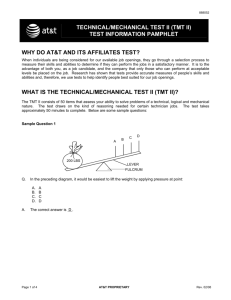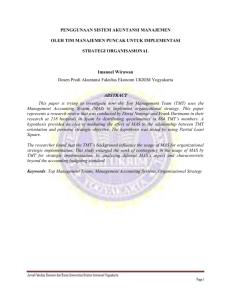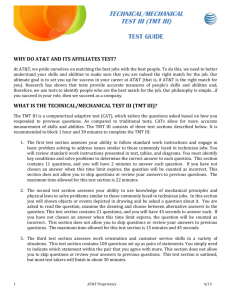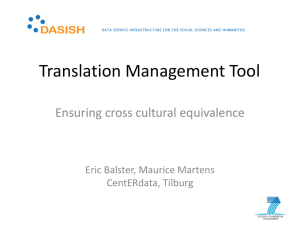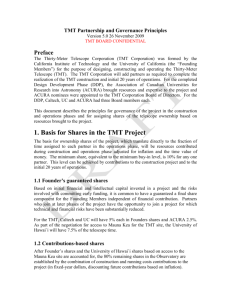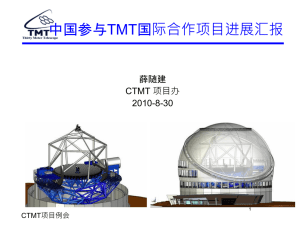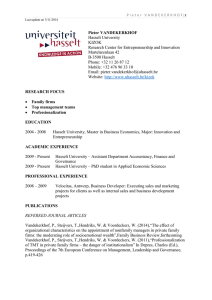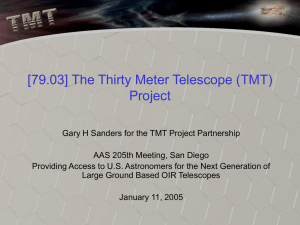MexicoNov06_siteV3
advertisement
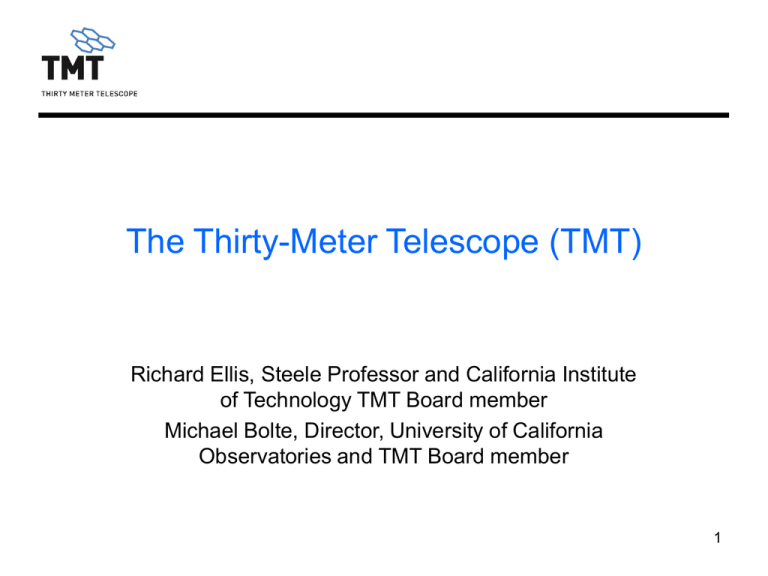
The Thirty-Meter Telescope (TMT) Richard Ellis, Steele Professor and California Institute of Technology TMT Board member Michael Bolte, Director, University of California Observatories and TMT Board member 1 Why a Thirty Meter Telescope? The decadal survey of astronomy carried out by the US National Academy of Sciences called for a thirty meter class telescope as the highest priority large groundbased project in astronomy for the next decade – To be built by a partnership of private and public sponsors – To be operating to overlap the observing by the James Webb Space Telescope, its highest priority space-based project The Canadian Long-Range Plan for Astronomy had similar goals A thirty meter telescope will have 144 times the light collection area and 12 times sharper resolution than the Hubble Space Telescope 2 3 TMT Project Scope Costs – – – – The current cost estimate for the project is $750M (US, 2005) $25M - $30M annual operating expense Ongoing development budget TBD $64M Design Development Phase (DDP) is underway Schedule – Construction start date: 2009 – “first light” date: 2015 – Facility lifetime: ~ 50 years 4 The TMT Partnership Current partners (for Design Development Phase) are: – – – – University of California (UC) Caltech ACURA (Canada) AURA (NSF) UC and Caltech designed, built and operate two 10-meter telescopes at the Keck Observatory in Hawaii Design Development Phase (DDP) – Currently $64M (US) is available from the Moore Foundation, Canada, and the US NSF to support the DDP – Goal is Preliminary Design of facility, risk (technical and fiscal) reduction to level of 25% overall contingency TMT Board of Directors is actively seeking additional partners 5 Public-Private Partnership UC and Caltech have successfully raised private funds for construction of their various observatories (Keck, Palomar, Lick, …) Private fund-raising for the TMT construction is high priority in the campaigns of UC and Caltech Canada is committed to raising 25% of both capital and operations costs In order to prepare credible construction proposals, we need to identify the source of operations funds in the next 12 months A new partner that could contribute $5M - $10M per year to operations would be very welcome 6 TMT Site Require a superb astronomical site for the TMT – Dark skies – Stable atmosphere above the site – Large fraction of clear nights A five-year effort of the TMT Project Site team is underway to characterize potential sites Robotic data collection underway at 3 sites in Chile, San Pedro Martir (Mexico), and Mauna Kea The most comprehensive (and ambitious) astronomical site survey work ever 7 TMT Site Selection Process Quality of the sites for carrying out astronomy research is crucial to the final selection Additional factors will also be considered such as: – – – – – – construction cost differentials operations costs differentials site permitting schedule and uncertainties arrangements with site host for share of telescope time shared infrastructure development costs Potential for partnership based on contributions to construction or operations Site testing will continue through Mar 07, final site recommendation to the Board in Mar 08 8 Mexico as a Partner Mexico is a welcome partner given its record of leading world-class astronomical facilities By joining TMT, Mexico gains immediate access to world’s biggest optical/IR telescope Opportunities for UNAM to contribute to state of the art instrumentation including adaptive optics Outreach opportunities bringing young people into science and technical fields Builds on success of Gran Telescopio Milimetrico: worldclass research facility with Mexico-US collaboration 9 Contact Information Ed Stone, Chair, Board of Directors, Thirty-Meter Telescope Project California Institute of Technology, Downs-218 Pasadena, CA 91125 +1 626 395 8321 ecs@srl.caltech.edu Gary Sanders, Project Manager, Thirty-Meter Telescope Project 1200 East California Boulevard, MC 102-8 Pasadena, CA 91125 USA +1 626 395 2997 sanders@tmt.org Richard Ellis, Board of Directors, Thirty-Meter Telescope Project California Institute of Technology,Astronomy 105-24 Pasadena, CA 91125 +1 626 295 2598 rse@astro.caltech.edu Michael Bolte, Board of Directors, Thirty-Meter Telescope Project University of California Observatories UC Santa Cruz, ISB-375 Santa Cruz, CA 95064 +1 831 459 2991 bolte@ucolick.org Further information: http://www.tmt.org/ 10 Backup Slides 11 TMT Science Highlights Detection and characterization of extra-solar planets Star and planetary system formation and evolution The initial epoch of star and galaxy formation and subsequent early evolution of galaxies The growth of supermassive black holes in the Universe Observational tests of fundamental physics New discovery space 12 SPM questions Permitting process, timeline and risks Construction costs specific to SPM Operations costs specific to SPM Arrangements for partnership with UNAM, Mexico and Baja California Astronomical “weather” compared to other sites 13
